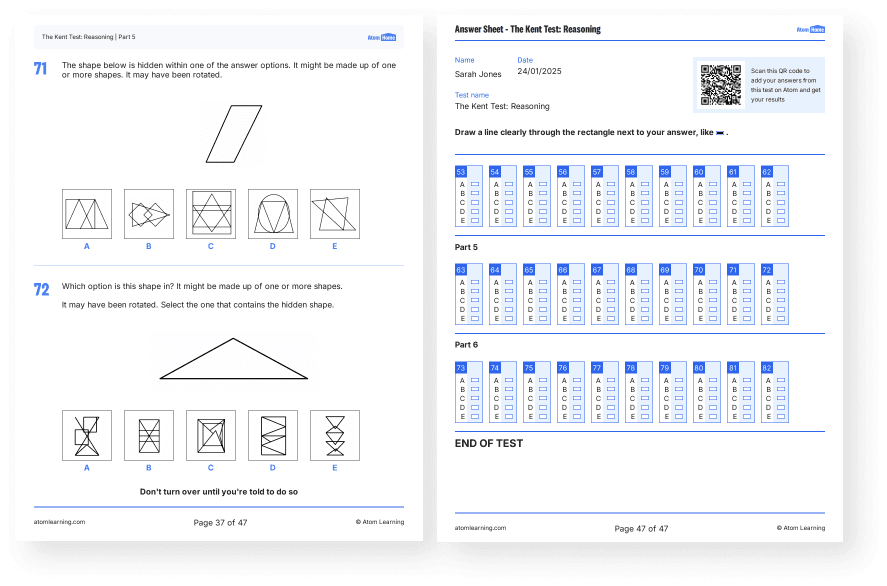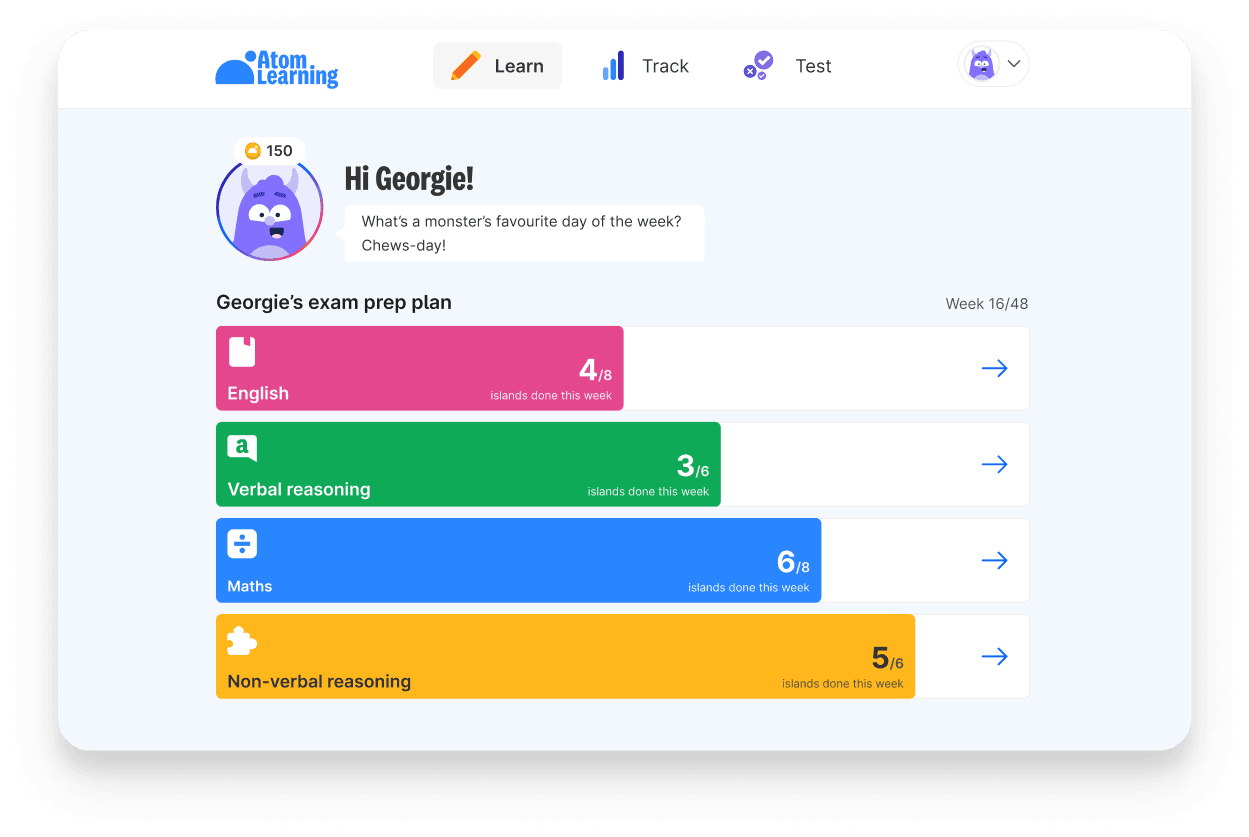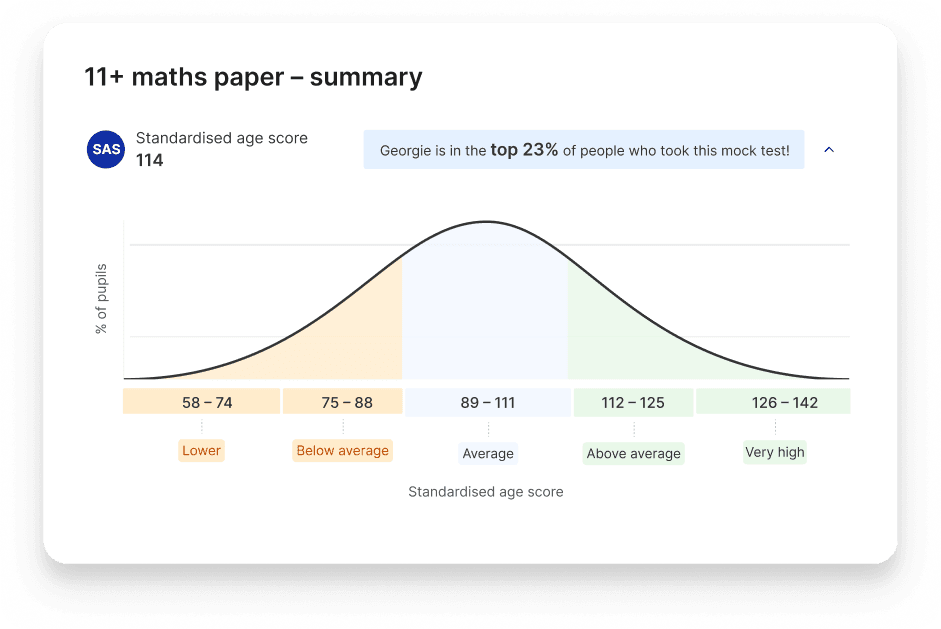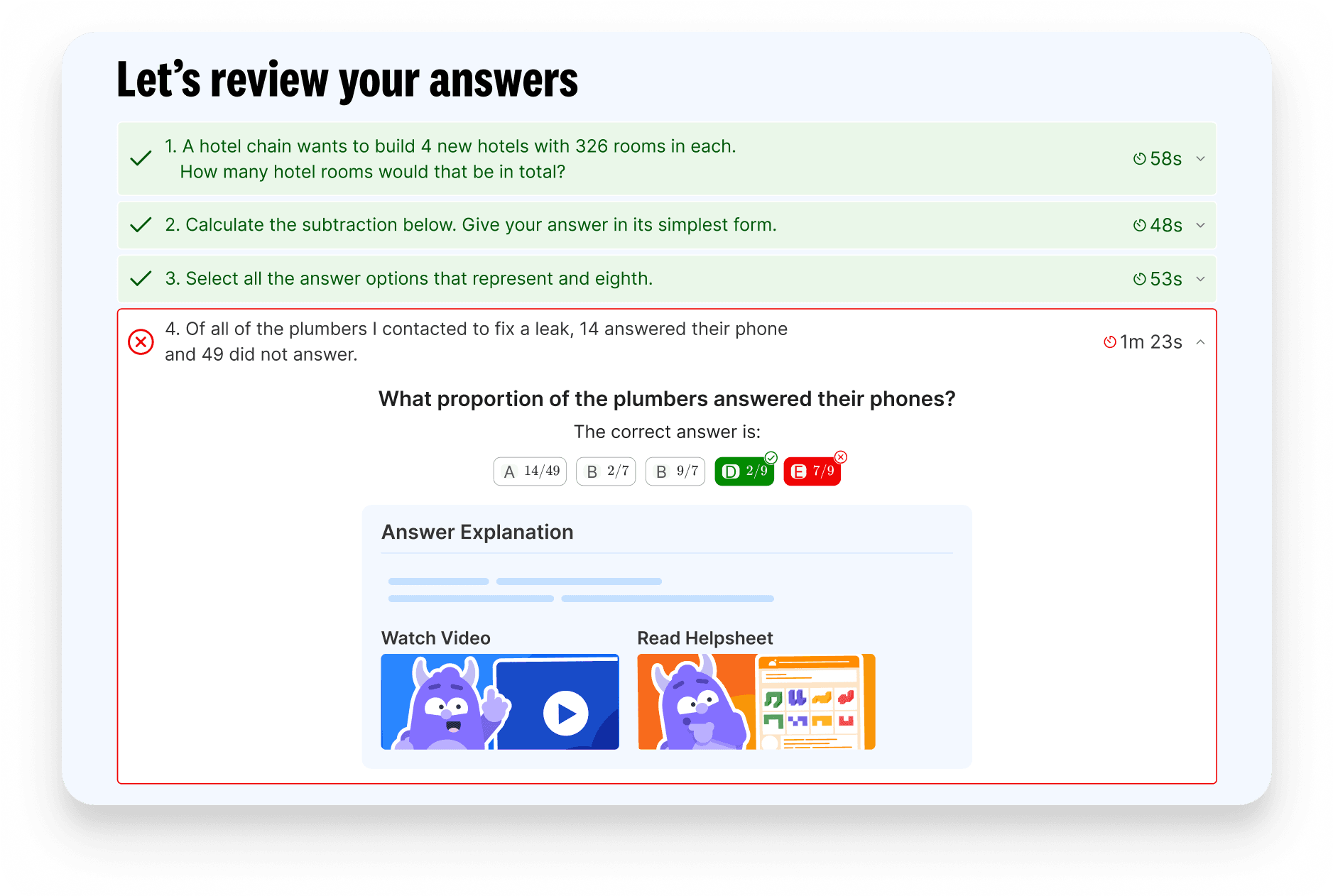Are you considering a grammar school for your child? Whether you’ve got a particular school in mind or you’re starting to research options, we’re here to help.
At Atom Learning, we’ve supported over 110,000 families with Key Stage 2 learning and school entrance exams. We speak to parents daily about school admissions, 11 plus exams, and how to help children prepare.
Key takeaways
Children applying to grammar schools take an academic test known as the 11 plus in the autumn term in Year 6.
11 plus exams can test a combination of English, maths, verbal reasoning and non-verbal reasoning. However, the specific content varies depending on the school.
11 plus exams are taken on paper and usually last around 2 hours. Most 11 plus exams are multiple-choice.
The 11 plus is challenging. It’s designed to identify children working at the top ability range in their year group.
Learning little and often and testing knowledge with 11 plus practice papers is the best way to prepare.
What is the 11 plus exam?
The 11 plus is an entrance exam. It's used by grammar schools to select children for Year 7. Grammar schools are free secondary schools in England that select pupils based on academic ability.
The name of the exam refers to the age at which children start secondary school (aged 11). Children take the 11 plus exam in Year 6 when they are 10 or 11 years old.
The 11 plus aims to test your child's attainment in core subjects, like English and maths. It can also identify your child's academic potential. Schools use the results of the 11 plus to decide which children are most likely to thrive in their school.
Selective independent schools (private schools) also have entrance exams. These are sometimes referred to as 11 plus exams. These might test similar subjects to grammar schools, but the admissions process and difficulty varies. This article focuses on grammar school exams.
When is the 11 plus in the UK?
The 11 plus is only used in England. There are no grammar schools in Scotland or Wales. The 11 plus was discontinued in Northern Ireland in 2008 and was replaced by an exam known as the Transfer Test.
Children taking the 11 plus in England take the exam in the autumn term of Year 6. Most schools hold the exam in September, although a few hold it in early October.
Grammar schools often release their 11 plus exam dates during the summer term in Year 5.
What does the 11 plus exam consist of?
The content of the 11 plus exam depends on your child's target school. Some grammar schools belong to consortiums, where all schools in the consortium use the same test. Others have unique tests specific to their school.
If you would like to apply to multiple grammar schools in one consortium, your child will only need to take one exam for those schools. If you would like to apply to schools outside of a consortium, your child will need to take an 11 plus test for each school.
11 plus exams assess some, or all, of these subjects:
English – usually reading comprehension and spelling, punctuation and grammar. A few 11 plus exams also test creative writing
11 plus English and maths tests assess Key Stage 2 topics. Your child will have been taught most of these topics in their English (or Literacy) and maths (or Numeracy) lessons. However, some 11 plus exams include Year 6 content that your child will not have learned yet. This is to assess how well they can apply problem-solving skills in unfamiliar situations.
Verbal reasoning and non-verbal reasoning are not included on the national curriculum. If your child is at a state primary school, they will not learn these subjects at school.
Reasoning tests your child's cognitive ability. This involves understanding patterns, spotting connections, and solving problems. Verbal reasoning involves letters and words, and non-verbal reasoning involves shapes and diagrams.
Learn more about 11 plus subjects
What is the format of the 11 plus exam?
The format of the 11 plus exam depends on the company providing the test.
Over 80% of grammar schools in England use 11+ exams created by GL Assessment. A few grammar schools use tests by FSCE (Future Stories Community Enterprise).
For both GL Assessment and FSCE exams, your child will have a question booklet and answer sheets. The answer sheets look a bit like lottery tickets. For each question, your child needs to shade the option (usually A–E) they think is correct on their answer sheet. The question will indicate whether they need to choose one or two answers. Your child should read the question carefully to avoid losing marks by not shading the right number of answer options.
After the exam, technology called Optical Mark Recognition (OMR) scans your child's answer sheets. Your child will receive a mark for every correct answer. It's important that your child fills in their answer sheets clearly so the technology can identify their answer.
Pictured: a downloadable 11+ practice paper and answer sheets available to Exam Prep Plus subscribers on Atom Home.
Some grammar schools create their own 11 plus test papers. For these, your child might need to write their answers in the question booklet. They might also need to provide short written answers.
If your child's 11 plus exam tests creative writing, they will need to provide a longer written answer. This is usually a response to a creative writing topic or prompt. Teachers and examiners mark creative writing tests.
What's on my child's 11 plus?
Not sure what 11 plus subjects your target school will test? We’ve got you covered. Find out everything you need to know about 11 plus exams in your local area.
How many questions are in the 11 plus exam?
The number of questions on your child's exam depends on the exam provider and the structure of the test.
Most GL Assessment 11 plus exams consist of two papers, but the subjects vary. Common GL Assessment 11+ combinations include, but are not limited to:
Two papers: one testing English and maths, the other testing verbal and non-verbal reasoning
Two papers: one testing English and verbal reasoning, one testing maths and non-verbal reasoning
Three papers: one testing English, one testing maths, and one testing either verbal or non-verbal reasoning (or a combination of both)
The 'standard' number of questions for full-length GL Assessment papers (one paper per subject) are:
English: 50 questions
Maths: 50 questions
Verbal reasoning: 80 questions
Non-verbal reasoning: 80 questions
How long is the 11 plus exam?
Each 11 plus exam paper usually lasts 45–60 minutes. This often includes a few minutes for unmarked practice questions. These help your child get comfortable with the style of questions before the test begins.
Most grammar school exams consist of two or three papers. These are usually taken on the same day, with a short break in the middle.
Some grammar schools spread the papers out over different days (such as consecutive Saturdays).
How hard is the 11 plus exam?
The 11 plus is designed to be challenging. Schools use the exam results to identify children working at the top ability range for their year – usually the top 25%. Even children who are working above the expected standard (sometimes called ‘Greater Depth’ in school reports) can find it difficult.
11 plus exams test knowledge and skills like problem-solving, comprehension, and logical thinking. Some children might find certain sections harder than others. What’s tricky for one child could be easier for another!
Learning with a ‘little and often’ approach and using the right resources can make the exam feel easier. Using 11 plus practice papers is a great way for your child to get used to the timing and layout of the exam.
Prepare for 11 plus success
Prepare for 11 plus exams the smart way with Atom Home. We’ve helped over 110,000 children build subject knowledge and prepare for entrance exams.
We believe that bitesize learning – little and often, over a long period of time – is the best way to prepare for exams. When you subscribe to Atom Home, you get a completely tailored experience that takes you from today to exam day. Set your target schools and we’ll build an exam prep plan that covers everything and makes the best use of every week.
What do I get with Atom Home?
For just one monthly subscription, Exam Prep Plus subscribers get:
Personalised learning plans outlining which topics to focus on each week
100,000+ interactive questions in English, maths, verbal and non-verbal reasoning
Unlimited online mock tests and unlimited downloadable paper tests
Intelligent tracking with detailed data on your child’s progress
Expert support with live lessons and webinars
Get started today – for free
91% of Atom users get a place at their top-choice school. See why families love using Atom – get started with your personalised learning plan today.
Who can take the 11 plus exam?
Any child applying for a grammar school can take the 11 plus exam. Children take the exam in the autumn term of Year 6 when they are 10 or 11 years old.
Eligibility depends on the schools your child is applying to. Some grammar schools have strict catchment areas. In some cases, if your child does not live in the catchment area, they will not be offered a place at the school – even if they pass the 11 plus.
Children must be registered to take the 11 plus exam. Every grammar school has a different registration period. Some open and close registration in the spring term of Year 5, while others don’t open until the summer. We always recommend checking the key dates and specific admissions criteria for your target schools.
When can my child take the 11 plus?
Your child will take the 11 plus in:
Autumn 2025 if they were born between 1st September 2014 – 31st August 2015
Autumn 2026 if they were born between 1st September 2015 – 31st August 2016
Autumn 2027 if they were born between 1st September 2016 – 31st August 2017
Autumn 2028 if they were born between 1st September 2017 – 31st August 2018
Should my child take the 11 plus?
Deciding whether your child should take the 11 plus comes down to your family’s goals and the schools you’re considering. If you’re applying to grammar schools, your child will need to take the exam as part of the admissions process.
The 11 plus is used to identify children working at the top ability range in their year group. If your child consistently achieves ‘greater depth’ or ‘exceeding expectations’ in Key Stage 2 English and maths, it could be a good fit.
It’s also worth considering whether these schools suit your child’s personality and learning style. Do they enjoy an academic challenge? Would they thrive in a fast-paced, competitive environment? If the answer is yes, the 11 plus might be a great next step.
That said, the exam is meant to be challenging, so preparation is key. It’s not something you can cram for at the last minute, but a ‘little and often’ approach to studying can make it feel less overwhelming.
At the end of the day, the decision should be about what’s best for your child. The 11 plus can open doors to fantastic schools, but it’s not the only path to success. What matters most is finding the right fit for them and their future.
How do I apply for the 11 plus exam?
You must register your child with the grammar schools you're applying to. Grammar schools have strict registration deadlines. Make sure to mark them in your calendar!
To register your child, you will need to complete a registration form. This is sometimes known as a Supplementary Information Form (SIF). You will need to provide details such as your child's name, date of birth, primary address, current school, and your contact details. The form will be available to download or complete on your target schools' websites.
Some grammar schools are members of consortiums, where all schools in the consortium use the same test. For example, all Gloucestershire grammar schools use the Gloucestershire Grammar Schools Entrance Test. If your child is applying to more than one school in a consortium, you might only need to complete one registration form. If you are applying for schools that do not belong to consortiums, you will need to complete a registration form for each school.
You'll find out whether your child is eligible for a place at your preferred grammar school(s) in October – a few weeks after the exam. If your child has achieved an eligible score, you can apply for a place. You will need to complete a secondary school common application form to do this.
When are 11 plus exam results?
11 plus exam results are sent in October in Year 6, before the deadline to apply for secondary school places (31st October). They are usually emailed to you by the school you registered your child with.
When you receive your child’s results, you might not get a full breakdown of their scores. Instead, you will learn whether their results make them eligible or not eligible for a place at the school.
How is the 11 plus marked?
Most 11 plus exams are multiple-choice and marked using Optical Mark Recognition (OMR). This technology scans your child’s answer sheets and assigns a mark for each correctly shaded answer.
11 plus exams are usually marked in two stages: raw scoring followed by age-standardisation.
1. Raw scoring
A raw score is the total number of correct answers your child gives on the test. Some exams have different sections (like English, maths, verbal reasoning, or non-verbal reasoning). Each section is scored separately.
2. Age standardisation
Age standardisation is a statistical process that includes your child’s age at the time of the test. Your child’s age is measured in years and months – for example, 10 years and 8 months. To ensure fairness, children’s raw scores are adjusted to account for their age. This means younger children in the year group aren’t at a disadvantage compared to their older peers. The adjusted score is called a Standardised Age Score (SAS) or Age-Standardised Score. This is the final score used by grammar schools to compare all applicants fairly.
The 11 plus marking process depends on the exam provider and the school. Some schools use ‘weighting’, where specific sections of the exam (e.g. English) have more value. Others might take an average across all sections.
It’s important to check the admissions criteria for the schools you’re applying to. Your target school’s admissions policy will outline how the exam is scored.
The image above shows a child’s standardised age score after taking an 11+ practice test on Atom Home. Georgie’s standardised age score was 114. When plotted onto a stanine curve (shown in the image), this score would place George as ‘above average’ for the year group. The score puts Georgie within the top 23% of pupils who took the test.
What is a good 11+ score?
Confused about age-standardisation? Want to know the pass mark for your target school? Learn everything you need to know about 11 plus marking.
Can you resit the 11 plus exam?
In most cases, your child will only be able to take the 11 plus exam once. If they don't achieve the required score, they won't be able to resit the exam for entry to the same school in the same year.
However, if your child is applying to different schools with separate 11 plus exams, they might have the opportunity to sit those. For example, grammar schools in different areas may use different tests. If your child is applying to different grammar schools, they might take multiple exams as part of the admissions process.
If your child is re-applying for entry the following year (into a higher year group), some schools might allow them to take the exam again. It's best to check with individual schools or local authorities to confirm.
If the 11 plus didn't go as planned, try to focus on what your child can learn from the experience. Every child develops at their own pace, and there are always other paths to success.
How do you pass the 11 plus exam?
Passing the 11+ exam comes down to preparation, practice, and understanding what's required. Here are our top tips to help your child succeed!
1. Understand the test format
The first step is to know exactly what your child will be tested on. The 11+ exam usually tests any combination of English, maths, verbal reasoning (VR) and non-verbal reasoning (NVR).
The subjects and format can vary depending on your target school or region. Make sure you check the specific requirements for your target schools.
2. Start preparation early
The 11+ exam is designed to be challenging. Starting early gives your child time to build their skills and confidence.
Most families begin earnest preparation in Year 4 or early Year 5. A 'little and often approach' works best. Regular, focused study sessions are much more effective than cramming!
Learn more about the best time to start 11 plus preparation.
3. Practise with the right materials
Use resources that mirror the style and difficulty of the 11+ exam. Practice questions and practice papers can help your child become familiar with the question types and timing.
Adaptive learning platforms like Atom Home tailor practice to your child’s strengths and areas for improvement. Preparation is more effective, as it keeps your child engaged and motivated to learn.
4. Focus on weak areas
It’s natural for children to find some areas more difficult than others. By identifying weaker topics, you can spend extra time reinforcing those skills. This targeted approach ensures steady progress and prevents frustration.
Atom Home removes the guesswork. Practice questions and practice tests are automatically-marked. Get feedback on every answer to learn from mistakes!
5. Build exam techniques
The 11+ is not just about knowledge; it’s about using that knowledge under time pressure. Teach your child how to manage their time, approach tricky questions, and stay calm during the test. Using practice papers under timed conditions can help with this.
6. Stay positive and supportive
The 11+ can feel overwhelming, so keeping a positive attitude is key. Encourage your child to focus on their progress rather than perfection. Building a growth mindset (where they see challenges as opportunities to learn) can make a big difference.
7. Take mock tests
Mock tests are invaluable for getting used to the structure and pressure of the real exam. They help your child understand what to expect, highlight areas for improvement, and boost their confidence before the big day.
8. Rest and recharge
Good preparation isn’t just about studying – it’s also about staying healthy and balanced. Make sure your child gets plenty of sleep, eats well, and has time for breaks, play, and relaxation. A well-rested mind is far better equipped to perform on exam day!
Not sure how to incorporate 11 plus prep into your child’s daily life? Read Atom’s 5 tips to build an effective study routine.
9. Know the exam day logistics
Before the big day, check the details: the time, location, what to bring, and any specific rules. Feeling prepared and organised will help your child stay calm and focused.
By taking a steady, well-structured approach to preparation, your child can go into the 11+ feeling confident and ready to give their best. Remember, this is a journey, and every step forward is a win!




